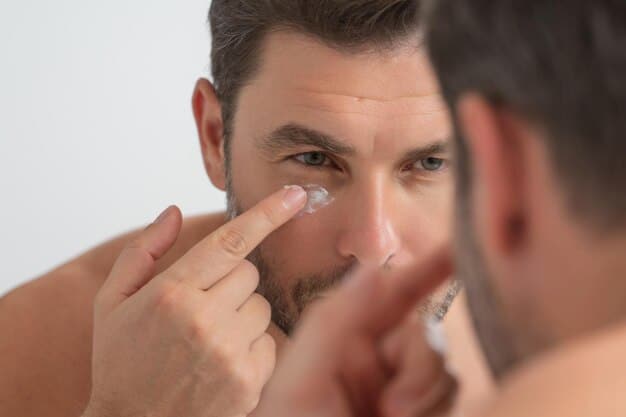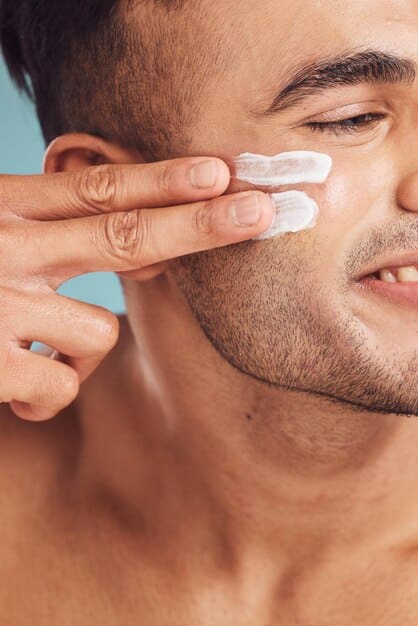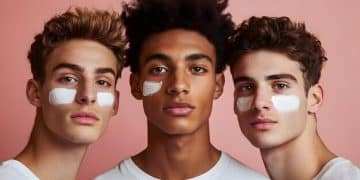Dark Circles Under Eyes: 4 Proven Treatments for Men That Actually Work

Persistent dark circles under the eyes in men can stem from various factors, including genetics, lifestyle, and aging, and effective treatment often combines medical interventions with consistent skincare routines and healthy habits to reduce their appearance.
For many men, the appearance of dark circles under eyes: 4 proven treatments for men that actually work can be a source of frustration, often making them look tired or older than they feel. This common aesthetic concern isn’t just about lack of sleep; it’s a multifaceted issue driven by genetics, lifestyle choices, and the natural aging process. Understanding the root causes is the first step toward finding effective solutions, which range from simple lifestyle adjustments to advanced dermatological procedures. This article will delve into the science behind these unwelcome shadows and explore four highly effective, proven treatments tailored specifically for men seeking tangible results.
Understanding the Causes of Dark Circles in Men
Dark circles are a widespread concern, but for men, understanding their specific origins can be crucial for effective treatment. While the immediate assumption often points to a lack of sleep, the reality is far more complex, involving a combination of physiological and lifestyle factors that can vary significantly from one individual to another.
One of the most common culprits behind persistent dark circles is genetics. If your parents or other close family members exhibit similar under-eye pigmentation, there’s a strong likelihood that you’ve inherited a predisposition. This can manifest as thinner skin around the eyes, which allows blood vessels to show through more prominently, or a natural tendency for increased melanin production in that area, leading to hyperpigmentation. Genetic dark circles are often more resistant to simple home remedies and may require more targeted interventions.
Thin Skin and Visible Blood Vessels
The skin beneath the eyes is remarkably thin, often just 0.5mm thick, compared to an average of 2-3mm on the rest of the face. This delicate nature makes the underlying blood vessels more apparent. When these capillaries dilate due to fatigue, allergies, or even excessive straining, they become more visible, casting a bluish or purplish tint that we perceive as dark circles.
Hydration also plays a pivotal role. Dehydration can cause the skin to lose its plumpness, making the eyes appear more sunken and the underlying blood vessels even more pronounced. Adequate water intake is foundational for overall skin health and can indirectly improve the appearance of the under-eye area.
Lifestyle Factors and Their Impact
Beyond genetics, lifestyle choices heavily influence the severity of dark circles. Chronic sleep deprivation is, of course, a prime suspect. When you don’t get enough restorative sleep, your skin becomes paler, and blood circulation can be impaired, making existing dark circles more noticeable.
* Allergies: Allergic reactions can trigger histamine release, leading to inflammation and dilation of blood vessels around the eyes, often accompanied by itchiness and rubbing, which exacerbates the problem.
* Diet and Nutrition: A diet lacking essential vitamins and minerals, particularly iron (leading to anemia) or B12, can contribute to paler skin and a more pronounced appearance of dark circles.
* Smoking and Alcohol: Both smoking and excessive alcohol consumption deplete the skin’s oxygen and vital nutrients, leading to premature aging, poor circulation, and increased visibility of under-eye discoloration.
* Excessive Sun Exposure: Unprotected exposure to the sun’s UV rays can stimulate melanin production in the delicate under-eye area, leading to hyperpigmentation, making dark circles darker and more persistent.
* Eye Strain: Prolonged screen time from computers, phones, or tablets can cause significant eye strain, dilating blood vessels around the eyes and contributing to the appearance of dark circles. Taking regular breaks and using proper screen distance can mitigate this.
The aging process also contributes to dark circles. As men age, the skin loses collagen and elastin, further thinning the under-eye area. Additionally, fat and bone loss in the mid-face can create hollows beneath the eyes, casting shadows that mimic dark circles, a phenomenon often referred to as a “tear trough deformity.” Understanding these varied causes is crucial, as a truly effective treatment plan usually involves addressing multiple factors rather than focusing on a single perceived problem.
Topical Creams & Serums: The First Line of Defense
For many men confronting dark circles, consistent use of topical creams and serums represents the most accessible and often effective starting point. The market is saturated with options, but identifying the right ingredients is key to achieving noticeable improvements, targeting issues like hyperpigmentation, puffiness, and the visibility of blood vessels.
These specialized products are formulated with active ingredients that work to address the various underlying causes of dark circles. Unlike general moisturizers, under-eye creams are designed with the delicate nature of the skin in mind, ensuring gentle yet potent delivery of beneficial compounds. The consistency and method of application are also crucial for maximizing their efficacy.
Key Ingredients and Their Benefits
When selecting an under-eye cream or serum, look for formulations that feature a blend of these powerful components:
* Retinoids (Retinol, Retinaldehyde): These vitamin A derivatives are champions of skin renewal. They stimulate collagen production, which
thickens the thin under-eye skin over time, making blood vessels less visible. Retinoids also accelerate cell turnover, helping to
reduce hyperpigmentation. Start with a low concentration to avoid irritation, especially in the sensitive eye area.
* Vitamin C: A potent antioxidant, Vitamin C brightens the skin by inhibiting melanin production, which is particularly useful for
dark circles caused by hyperpigmentation. It also plays a crucial role in collagen synthesis, improving skin firmness and reducing
the appearance of fine lines around the eyes.
* Hyaluronic Acid: This powerhouse humectant attracts and holds up to 1,000 times its weight in water, providing intense hydration.
By plumping the skin, hyaluronic acid can soften the appearance of hollows and make the under-eye area look smoother and more
voluminous, thus minimizing shadows.
* Caffeine: Commonly found in eye creams, caffeine is a vasoconstrictor, meaning it temporarily constricts blood vessels. This
can reduce puffiness and diminish the appearance of dark circles caused by dilated capillaries, offering a quick, albeit temporary,
revitalization.
* Niacinamide (Vitamin B3): Niacinamide is a versatile ingredient that helps improve skin barrier function, reduce inflammation, and
even out skin tone. It can be beneficial for dark circles caused by hyperpigmentation and general skin dullness.
* Peptides: These short chains of amino acids are the building blocks of proteins like collagen and elastin. Different peptides
can signal the skin to produce more collagen, improve lymphatic drainage, or even calm inflammation, contributing to overall
under-eye health and appearance.
* Kojic Acid, Licorice Root Extract, Arbutin: These are effective brightening agents that work by inhibiting tyrosinase, an enzyme
necessary for melanin production. They are particularly useful for men whose dark circles are due to excessive pigmentation.
Application Techniques for Maximum Impact
The way you apply these products can significantly impact their effectiveness. A common mistake is to rub the cream vigorously, which can drag and irritate the delicate skin. Instead, dispense a pea-sized amount for both eyes onto your ring finger. Gently dab the product along the orbital bone, moving from the inner corner outwards. Use a light, tapping motion until the product is fully absorbed. Apply twice daily, ideally in the morning and before bed, after cleansing and toning your face. Consistency is paramount; results typically take several weeks to months to become noticeable as skin renewal and collagen production are gradual processes. Protecting the area with daily SPF is also critical, as sun exposure can reverse the benefits of brightening ingredients and exacerbate existing pigmentation.

Dermal Fillers: Addressing Volume Loss and Shadows
When dark circles are primarily due to volume loss, creating hollows and noticeable shadows beneath the eyes, topical treatments may not be enough. This is where dermal fillers, specifically hyaluronic acid-based fillers, come into play as a highly effective solution for men. By delicately restoring lost volume in the tear trough area, fillers can immediately smooth out shadows and create a more refreshed, youthful appearance.
The tear trough is the indentation that runs from the inner corner of the eye, diagonally down toward the cheek. As we age, fat pads in this area can atrophy, and bone structure can recede, leading to a deeper hollow. This hollow catches light differently, casting a shadow that is perceived as a dark circle, even if there isn’t actual hyperpigmentation of the skin itself. For men, this can be particularly aging, as it often conveys a perpetually tired look.
The Science Behind Tear Trough Fillers
Hyaluronic acid fillers, such as Restylane and Juvederm, are gel-like substances that are naturally occurring in the body. When meticulously injected by a skilled practitioner into the tear trough, they act as a scaffold, lifting the skin and filling the hollow. This evens out the contour from the lower eyelid to the cheek, eliminating the shadow effect. The result is a smoother transition and a brighter, more even under-eye area.
* Procedure Overview: The procedure is relatively quick, typically lasting 15-30 minutes. A numbing cream may be applied beforehand to enhance comfort. The filler is precisely injected using fine needles or cannulas to minimize bruising and swelling.
* Immediate Results: One of the primary advantages of dermal fillers is that results are often visible immediately. The area appears smoother and less hollow, and the shadows are significantly reduced.
* Longevity: The effects of tear trough fillers are not permanent but typically last between 9 to 18 months, depending on the specific filler used, individual metabolism, and lifestyle factors. Maintenance injections are required to sustain the results.
* Safety Profile: When performed by an experienced and qualified injector, dermal fillers are generally safe. However, potential side effects include temporary swelling, bruising, redness, or tenderness at the injection site. More serious, albeit rare, complications can occur, underscoring the importance of choosing a board-certified dermatologist or plastic surgeon.
The art of injecting fillers in the tear trough requires an intricate understanding of facial anatomy and a delicate touch. Overfilling can lead to a puffy “pillow face” appearance, while improper placement can result in lumps or a bluish discoloration known as the Tyndall effect. Therefore, selecting a practitioner with extensive experience in male facial aesthetics and specifically in tear trough correction is paramount for natural-looking and effective results. This treatment offers a more dramatic and immediate improvement for volume-related dark circles than topical creams alone.
Laser Therapy & IPL: Targeting Pigmentation and Vessels
For men whose dark circles are caused by excessive pigmentation (brownish discoloration) or prominent blood vessels (bluish/purplish tint), advanced light and laser therapies offer highly effective solutions. These treatments work by selectively targeting pigments or vascular structures without damaging the surrounding skin, leading to a clearer, more even under-eye complexion.
The principle behind laser and Intense Pulsed Light (IPL) therapies involves using specific wavelengths of light energy to address the root cause of discoloration. Different types of lasers and IPL devices are employed depending on whether the primary concern is melanin (pigment) or hemoglobin (red blood cells in vessels).
Targeting Brown Pigmentation with Lasers and IPL
For dark circles stemming from hyperpigmentation, often characterized by a brown or grayish hue, treatments like PicoSure, Fraxel, or certain types of IPL are highly beneficial. These technologies deliver short pulses of light energy that are absorbed by the melanin in the skin. The heat from the absorbed light shatters the melanin into microscopic particles, which are then naturally cleared away by the body’s lymphatic system.
* IPL (Intense Pulsed Light): While not a true laser, IPL uses
broad-spectrum light with different filters to target various skin concerns, including brown spots and redness. For pigmented
dark circles, specific IPL settings can effectively reduce melanin concentrations, leading to a brighter under-eye area. Multiple
sessions are typically required.
* Pico Lasers (e.g., PicoSure): These advanced lasers deliver
energy in picosecond (trillionths of a second) pulses. This ultra-fast delivery creates a photomechanical effect that shatters
pigment without generating much heat, minimizing thermal damage and reducing downtime. Pico lasers are highly effective for
stubborn hyperpigmentation and are generally safe for various skin tones.
* Fractional Non-Ablative Lasers (e.g., Fraxel Clear + Brilliant): These lasers create microscopic treatment zones in the skin,
triggering the body’s natural healing process to produce new, healthy cells and collagen. While primarily used for texture and
fine lines, they can also improve skin tone and reduce pigmentation over several sessions.
The number of sessions required varies depending on the severity of the pigmentation and the specific laser used, but typically ranges from 3 to 6 treatments, spaced several weeks apart. Mild redness and swelling are common post-treatment but usually subside within a few days.
Addressing Blue/Purple Vascular Circles
When dark circles have a bluish or purplish cast, it often indicates visible veins or capillaries beneath the thin skin. For these vascular dark circles, specific lasers that target hemoglobin are more effective:
* Pulsed Dye Lasers (PDL) (e.g., Vbeam): PDLs emit a concentrated beam of light that is specifically absorbed by the oxyhemoglobin
in blood vessels. This targets and seals off the problematic veins, making them less visible. PDL is often considered the gold
standard for treating vascular lesions and can significantly reduce the blue/purple appearance of dark circles. Temporary bruising
(purpura) is a common side effect, lasting for about a week.
* Nd:YAG Lasers (Long-Pulsed): Certain long-pulsed Nd:YAG lasers can also effectively target deeper blood vessels. These lasers
have a longer wavelength, allowing them to penetrate deeper into the skin to coagulate and collapse the superficial veins causing
discoloration.
These vascular laser treatments typically require fewer sessions than pigmentation treatments, sometimes only 1-3 sessions are needed. A thorough consultation with a board-certified dermatologist or plastic surgeon is essential to determine the most appropriate laser or IPL treatment based on the specific type of dark circles and individual skin characteristics. Proper eye protection is mandatory during these procedures.
Lifestyle Adjustments & Home Remedies: Supporting Overall Eye Health
While professional treatments offer significant improvements for dark circles, their efficacy is significantly bolstered by maintaining a healthy lifestyle and incorporating simple, consistent home remedies. These daily habits play a crucial role in preventing new discoloration and sustaining the results achieved through more intensive interventions for men. Often, the cumulative effect of these practices can be surprisingly impactful.
For many men, the appeal of lifestyle adjustments lies in their accessibility and the overall health benefits they offer. They represent a holistic approach, addressing not just the symptom of dark circles but also the underlying factors that contribute to tired-looking eyes and dull skin.
The Power of Quality Sleep and Hydration
Undoubtedly, sufficient and restful sleep is one of the most powerful remedies for dark circles. Aim for 7-9 hours of quality sleep per night. Elevating your head slightly with an extra pillow can help prevent fluid accumulation under the eyes, reducing morning puffiness.
Hydration is equally vital. Dehydration can make the skin appear dull and thin, emphasizing blood vessels. Ensuring you drink at least eight glasses of water daily helps maintain skin plumpness and elasticity, contributing to a healthier under-eye appearance. Limiting excessive caffeine and alcohol, which are diuretics, can also aid in maintaining proper hydration levels.
Diet, Nutrition, and Supplementation
A balanced diet rich in essential vitamins and minerals can significantly impact skin health. Incorporate foods high in:
* Iron: Red meat, spinach, lentils, and fortified cereals can help prevent anemia, a common cause of pale skin that makes dark circles more apparent.
* Vitamin C: Citrus fruits, berries, and leafy greens are crucial for collagen production and act as antioxidants, brightening the skin.
* Vitamin K: Found in leafy greens, broccoli, and Brussels sprouts, Vitamin K aids in blood clotting and can help reduce the visibility of broken capillaries.
* Antioxidants: Berries, dark chocolate, and green tea combat oxidative stress, which can damage skin cells and contribute to premature aging and pigmentation.
Consider consulting a healthcare professional about supplements if your diet lacks specific nutrients. However, supplements should always complement, not replace, a wholesome diet.
Sun Protection and Allergic Reaction Management
Protecting the delicate under-eye skin from sun exposure is non-negotiable. UV radiation stimulates melanin production, exacerbating hyperpigmentation. Using an SPF 30 or higher broad-spectrum sunscreen specifically around the eyes daily is critical. Wearing sunglasses that block 99-100% of UV rays provides an additional layer of protection, especially during prolonged outdoor activities.
For men with allergies, managing symptoms is paramount. Allergic rhinitis often leads to nasal congestion, which can darken the veins under the eyes (allergic shiners). Taking prescribed antihistamines, avoiding triggers, and using saline nasal rinses can reduce inflammation and minimize the appearance of these circles. Rubbing or itching the eyes due to allergies can also worsen discoloration and should be avoided. Applying a cold compress to the eyes can also help constrict blood vessels and reduce puffiness. These simple yet effective practices, when consistently applied, can significantly enhance the results of any cosmetic treatments and contribute to overall well-being.

Combination Approaches: Synergistic Results
For many men, achieving optimal results in treating dark circles necessitates a multi-faceted approach. While each of the previously discussed treatments offers distinct benefits, combining therapies can often lead to synergistic improvements, addressing multiple contributing factors simultaneously and yielding more comprehensive and lasting outcomes. This integrated strategy recognizes that dark circles are rarely caused by a single issue, but rather by a complex interplay of genetics, lifestyle, and physiological changes.
A dermatologist or plastic surgeon specializing in male aesthetics can help design a customized treatment plan that strategically combines different modalities. The most effective combination will depend on the primary cause of your dark circles — whether it’s primarily pigmentation, volume loss, vascular issues, or a mix of all three.
Tailored Treatment Plans
For instance, a man experiencing both significant volume loss and some degree of hyperpigmentation might benefit immensely from a combination of:
* Dermal Fillers: To directly address the hollows and shadows created by volume depletion, providing immediate structural support to the under-eye area.
* Topical Brightening Serums: Applied consistently post-filler procedure, these serums (containing ingredients like Vitamin C, retinol, or niacinamide) can work on the skin’s surface to reduce melanin buildup, further brightening the area and improving skin texture.
This approach tackles both the structural (volume) and superficial (pigmentation) aspects, leading to a much more complete resolution than either treatment could achieve alone.
Consider another scenario: a man with noticeable vascular dark circles and puffiness caused by fluid retention. A tailored combination might include:
* Pulsed Dye Laser (PDL) or Nd:YAG Laser: To target and reduce the visibility of the underlying blue/purple blood vessels, directly addressing the vascular component.
* Caffeine-infused Eye Creams: Used daily, caffeine can help constrict superficial blood vessels and reduce temporary puffiness, complementing the laser’s effects and offering a daily maintenance solution.
* Lifestyle Adjustments: Emphasizing adequate sleep, reduced sodium intake, and regular hydration to minimize fluid retention and support overall under-eye health.
The Value of Patience and Consistency
Regardless of the chosen combination, patience and consistency are critical. Cosmetic treatments often require multiple sessions and gradual improvements rather than instant miracles. Home care, including topical applications and lifestyle adjustments, must be maintained diligently to support and prolong the results of professional procedures. Regular follow-up appointments with your chosen specialist are also essential to monitor progress, make any necessary adjustments to the treatment plan, and address new concerns as they arise. This collaborative and ongoing effort between the patient and practitioner is what truly defines a successful long-term strategy for diminishing dark circles.
Preventative Measures for Sustained Results
Maintaining the positive changes achieved from dark circle treatments requires a proactive approach centered on prevention. For men, integrating preventative measures into their daily routine can significantly prolong the benefits of any cosmetic intervention and reduce the likelihood of dark circles recurring. These measures span across skincare, lifestyle, and environmental protection, forming a comprehensive strategy for sustained under-eye health.
Prevention isn’t merely about avoiding the causes; it’s about building a robust defensive strategy that supports the delicate under-eye area. This not only keeps dark circles at bay but also contributes to overall facial rejuvenation, projecting a more vibrant and alert appearance.
Consistent Skincare Routine
A consistent and appropriate skincare routine is fundamental. Your daily regimen should specifically cater to the needs of the under-eye skin:
* Gentle Cleansing: Use a mild cleanser to remove impurities without stripping the skin’s natural oils.
* Targeted Eye Cream: Continue using an eye cream with active ingredients (e.g., Vitamin C, peptides, hyaluronic acid) even after the appearance of dark circles has diminished. This maintains hydration, support collagen production, and provides antioxidant protection.
* Sun Protection: Daily application of a broad-spectrum SPF 30+ specifically formulated for the face (or a dedicated eye-safe sunscreen stick) is indispensable. UV radiation is a major culprit in aggravating dark circles. Wear quality sunglasses that block 99-100% of UV rays whenever outdoors.
Holistic Lifestyle Management
Beyond skincare products, lifestyle choices significantly impact the appearance of your eyes. Prioritizing these aspects contributes directly to prevention:
* Adequate Sleep: Aim for 7-9 hours of uninterrupted sleep each night. Establish a consistent sleep schedule to regulate your body’s natural rhythms.
* Hydration: Drink plenty of water throughout the day. Well-hydrated skin is plumper and less likely to show underlying vascularity.
* Balanced Diet: Consume a diet rich in fruits, vegetables, and lean proteins. Foods high in antioxidants and essential vitamins (like Vitamin K and C) bolster skin health and capillary strength. Reduce excessive salt intake, which can lead to fluid retention and puffiness.
* Stress Reduction: Chronic stress can impact sleep quality and general well-being, contributing to a tired appearance. Incorporate stress-relief techniques like meditation, exercise, or hobbies.
* Minimize Eye Strain: Take regular breaks if you spend long hours in front of screens. The 20-20-20 rule (every 20 minutes, look at something 20 feet away for 20 seconds) can help prevent eye fatigue.
Managing Allergies and Environmental Factors
For men prone to allergic shiners, proactive allergy management is key. Identify and avoid allergens where possible, and take prescribed antihistamines or use nasal sprays as directed by a doctor. Avoiding excessive eye rubbing, a common response to irritation, is also crucial, as it can worsen pigmentation and inflammation. Furthermore, minimizing exposure to environmental pollutants and irritants can protect the delicate under-eye skin from oxidative damage and premature aging. By consistently implementing these preventative measures, men can not only treat existing dark circles effectively but also safeguard their under-eye health for the long term, ensuring a perpetually refreshed and alert look.
When to Consult a Professional
While at-home remedies and consistent skincare can offer significant improvements for dark circles, discerning when to seek professional medical advice is a crucial step for men who are not seeing desired results or suspect an underlying health issue. A dermatologist or plastic surgeon can provide an accurate diagnosis of the cause of your dark circles and recommend appropriate, more advanced treatments. This professional consultation goes beyond aesthetic concerns, ensuring that the dark circles are not symptomatic of a more serious condition.
It’s important to recognize that self-diagnosis can be misleading, and what appears to be a cosmetic issue might be a signpost for something deeper. For men, who may traditionally be less inclined to seek specialized skincare advice, understanding the triggers for professional consultation is paramount.
Signs It’s Time to See a Specialist
Several indicators suggest that your dark circles warrant a professional medical review:
* No Improvement with Home Remedies: If you’ve diligently tried topical creams, lifestyle adjustments, and consistent habits for several months without any noticeable change, it’s a strong sign that the underlying cause may require professional intervention, such as medical-grade treatments or procedures.
* Sudden Onset or Worsening: A rapid or unexplained onset of dark circles, or a sudden and significant worsening of existing ones, should prompt a visit to a doctor. This could indicate a new underlying health condition that needs addressing.
* Associated Symptoms: If your dark circles are accompanied by other symptoms such as severe fatigue, unexplained weight loss, changes in vision, swelling in other parts of the body, or significant itchiness and redness, it could point to systemic health issues like thyroid problems, kidney disease, severe allergies, or nutritional deficiencies.
* Concerns About Underlying Health: Men who suspect their dark circles might be linked to chronic conditions (e.g., anemia, liver issues, heart problems) or who have a family history of such conditions should consult their general practitioner for a thorough medical check-up before seeking cosmetic solutions.
* Desire for More Dramatic or Permanent Results: For men seeking more significant or longer-lasting improvements than what topical products can offer, a consultation with a cosmetic dermatologist or plastic surgeon is appropriate. They can discuss options like dermal fillers, laser therapies, or even surgical solutions if warranted.
During a professional consultation, the specialist will typically examine your under-eye area, discuss your medical history, lifestyle habits, and previous treatments. They may also ask about your family history regarding dark circles. Based on this comprehensive assessment, they can then recommend the most effective and safest course of action, which might include further diagnostic tests, prescription-strength topicals, in-office procedures, or a referral to another medical specialist. This proactive step ensures that dark circles are treated effectively, safely, and appropriately, addressing both cosmetic concerns and potential health considerations.
| Key Treatment | Brief Description |
|---|---|
| 🌿 Topical Creams & Serums | Cosmetic products with active ingredients like retinol, Vitamin C, and hyaluronic acid to brighten and hydrate. |
| 💉 Dermal Fillers | Hyaluronic acid injections to restore lost volume in the tear trough, reducing shadows. |
| ✨ Laser Therapy & IPL | Light-based treatments targeting pigmentation (brown) or visible blood vessels (blue/purple). |
| 🍎 Lifestyle Adjustments | Holistic changes like adequate sleep, hydration, balanced diet, and sun protection. |
Frequently Asked Questions About Dark Circles
Men are prone to dark circles for similar reasons as women, including genetics, thin skin revealing blood vessels, and lifestyle factors like lack of sleep or dehydration. Biological differences in testosterone and skin thickness can also play a role, but the root causes are largely universal. Addressing underlying issues like allergies or volume loss is key to effective treatment.
While usually benign, persistent dark circles can sometimes signal underlying health issues like anemia, thyroid problems, kidney disease, or severe allergies. If accompanied by other symptoms like extreme fatigue, unexplained weight loss, or swelling, it’s advisable to consult a doctor to rule out any serious medical conditions requiring attention.
Yes, for severe cases, particularly those involving excess skin, fat herniation (bags under eyes), or significant tear trough deformity, surgical options exist. Blepharoplasty (eyelid surgery) can remove excess skin and fat, while fat grafting (transferring fat from another body area) can address significant volume loss. These are more invasive and typically reserved for cases unresponsive to non-surgical treatments.
The timeline varies significantly by treatment. Dermal fillers often show immediate improvements for volume loss. Topical creams require consistent use for weeks to months to see noticeable brightening or skin thickening. Laser therapies typically show gradual results over several sessions, with full effects appearing weeks after the final treatment. Patience and adherence to the regimen are crucial.
Yes, a diet rich in iron, Vitamin C, Vitamin K, and antioxidants can support overall skin health and reduce dark circles. Iron prevents anemia, which can cause paleness. Vitamin C aids collagen production and brightening. Vitamin K improves capillary strength. Reducing sodium intake can lessen puffiness. A balanced diet complements other treatments effectively.
Conclusion
Effectively tackling dark circles under the eyes for men involves a nuanced understanding of their varied causes, ranging from genetics and lifestyle to the natural aging process. From the consistent application of advanced topical creams and serums to the targeted precision of dermal fillers and laser therapies, a range of proven treatments offers significant opportunities for improvement. Beyond professional interventions, foundational elements like adequate sleep, proper hydration, a balanced diet, and diligent sun protection remain indispensable. By adopting a comprehensive, multi-faceted approach, men can significantly reduce the appearance of dark circles, achieving a more refreshed, vibrant, and confident look that truly works.





